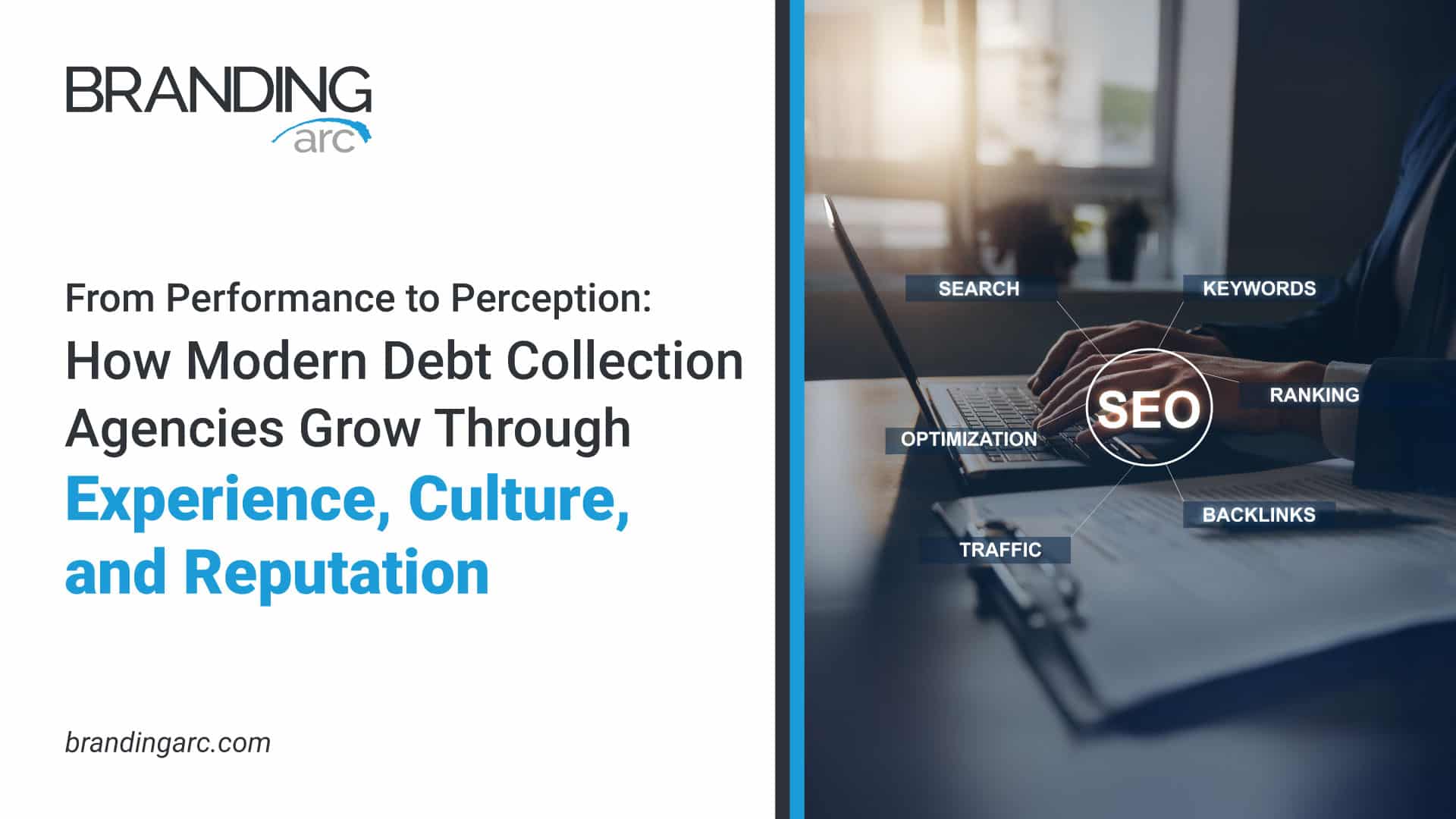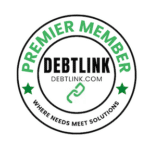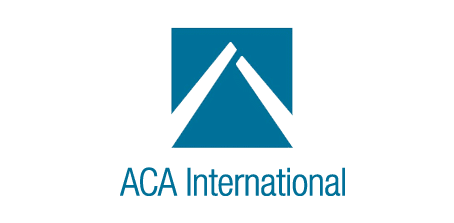5 Most Common Marketing Problems & Solutions in the Receivables Industry

In the fast-paced world of receivables management, effective marketing is not just a luxury but a strategic necessity. While there are many players within the industry (debt buyers, collection agencies, debt brokers, law firms, etc), we ultimately find ourselves all grappling with the same marketing challenges. In this article, we delve into the five most prevalent marketing obstacles in the receivables industry, and more importantly, offer actionable solutions to overcome them.
1. Misunderstanding Marketing vs. Sales
In some companies, the lines between marketing and sales can become a bit blurred, leading to several problems. By clearing up the positions of both departments, we can easily identify the largest hurdle created by this misunderstanding.
The Sales Funnel
To delve into the differences between marketing and sales, we begin with the analogy of the “sales funnel.” The top of the funnel represents awareness and interest in a product or service, and is where there is a wide pool of prospects. As you move downward, the funnel becomes gradually narrower and you encounter different stages of the sales cycle, such as consideration, intent, and finally, conversion into a paying customer.
The role of marketing sits at the rim, or ‘event horizon’ of the sales funnel, pouring potential leads into the funnel, but not passing into the actual sales funnel. Its primary focus is to attract and engage a large audience, casting a wide net by generating brand recognition and sparking interest within the marketplace. This includes strategies like advertising, content creation, social media engagement, SEO (Search Engine Optimization), and PR (Public Relations).
Sales comes into play further down the funnel, where prospects have progressed from being merely aware or interested to actively considering a purchase.
1:1 vs 1:Many
Another way to examine the difference between marketing and sales is to consider the differences in the relationships with each department’s respective audiences. For sales, the relationship is very 1:1 as sales representatives engage with qualified leads on a more personal level, guiding them down through the stages of the funnel to, hopefully, a sales conversion. Whereas for marketing, the relationship is more of a 1:Many dynamic as the goal is to cast that wide net of interest and awareness that can then be poured into the funnel.
This dichotomy between the two relationship types is directly related to the largest hurdle that arises when the lines between marketing and sales are blurred in an organization: the art of effective communication.
The Art of Effective Communication
It is truly an art form to navigate communication to the masses from a marketing standpoint, and it is equally challenging and requires tact to communicate effectively with prospects one on one in a sales setting, but the two communication styles are very different. The language used in marketing communications is primarily focused on three things:
- Relevancy – making your brand/company relevant
- Frequency – making sure outreach/touches are frequent so that people remember who you are and what your brand is about
- Authority – establishing your company as a voice of authority/an expert in the space
Your reputation as a company is intimately tied to the sum of what everyone around you in the marketplace thinks of your brand — whether it is true or not. So it is the role of marketing to push the relevancy, frequency, and authority of your voice in order to set a precedent for your company’s overall reputation. When the relationship progresses into the sales funnel and becomes 1:1, the communication style and language need to change from establishing reputation, to focusing on the client, their needs and wants, and how you specifically solve their pain points.
2. Content
Writing content is the most difficult part of building a website and creating marketing materials. The choice of language and balance of keywords have a direct impact on the quality of your content and its success with search engines. Furthermore, within such a highly litigious industry, we face a myriad of difficulties regarding what we can say, and how it should be said.
The Challenge of 3 Audiences
In the receivables management industry, we have three primary audiences that may be consuming our content at any given time: clients, consumers, and regulators. When drafting content you have to be conscious of how each audience member is viewing the information, and try to craft the language to resonate with all three simultaneously.
From a client’s perspective, they are viewing things through a stakeholder lens, which means the content should demonstrate expertise, reliability, and the ability to deliver results while adhering to legal and ethical standards. For consumers, they are often approaching our industry in a state of vulnerability and, as such, the content should try to strike a balance between transparency, empathy, and clear guidance in order to build trust and establish a willingness to engage. All the while, the same text should prioritize adherence to legal requirements, compliance frameworks, and ethical practices for regulators reviewing the content.
“We Have Nothing to Talk About”
With the challenge of crafting content that resonates with three distinct audiences coupled with the challenge of compliance, it can often be difficult for a company within the industry to even want to produce content. In these situations, we are often met with the response, “we have nothing to talk about.” However, despite all of the challenges behind content creation, there are a myriad of different topics and discussions that every company can be having within the marketplace, including: thought leadership topics, industry event attendance, product or services updates, current events, company highlights (promotions, company events, community involvement, etc.), and more. There is a wealth of knowledge within each organization and it comes down to frequently building content around that in order to establish authority and relevancy within the marketplace.
Buzzword Bingo
Another challenge to be wary of when dealing with content creation, is avoiding playing the game of “buzzword bingo.” This is a phenomenon where keywords or “buzzwords” are used frequently within content, but without providing any substantial value or deeper understanding of the subject matter. For example, a company that builds AI may write a web page intended to share information about their product or service, but after reading paragraph after paragraph stuffed with AI buzzwords, the reader is left scratching their head about what the company actually provides. Instead of being clear and concise with the content, the focus was turned to buzzwords to try to generate interest that, ultimately, impeded the company’s messaging.
3. Online Presence
In the digital age, establishing a strong online presence is essential for businesses to both survive and thrive. Digital marketing serves as a powerful tool in this arena, enabling businesses to engage with their target audience through valuable and relevant content. In this digital marketing landscape, there are three main points of consideration: SEO, Websites, and Social Media.
SEO
While we often discuss the three audiences within our industry, there is actually a fourth audience that is constantly judging all web-based content and whose “opinion” can make or break your ability to even be seen: Google. Google is constantly indexing and ranking online content and granting visibility to sites and links where it deems the content to be the most relevant and authoritative. This is where SEO, or Search Engine Optimization, comes into play. SEO is the process of optimizing a website to improve its visibility and ranking on Search Engine Results Pages (SERPs), and it involves various strategies such as keyword research, content optimization, and link building to enhance a website’s relevance and authority.
When writing content for a website, you want to be aware of the relevant keywords that you want to rank for in a search. For example, a local pizza restaurant will want to rank for ‘pizza’ and the name of their local town. However, there is a very fine line between writing content that mentions keywords enough to rank, and the threshold where Google considers it “keyword stuffing,” or the repetition of a word/phrase to the point of irrelevance and the page will no longer rank for said keyword. The easiest way to avoid this is by using a digital check system linked to the website that will scan the content for keyword density.
SERPs & Websites
A Search Engine Results Page (SERP) is the page displayed by a search engine in response to a query. This is extremely important in the receivables management industry because it determines the visibility and accessibility of a company’s website and content, which directly impacts both reputation and traffic. The SERP is essentially a company’s first impression, and if the results are negative whether from reviews or attackers promoting litigation, it can and will have a drastically negative impact.
Your website is the second impression and the keystone to a company’s digital presence. What a potential client or consumer sees on a receivables website has a direct impact on both their understanding and opinion of the organization. It is also the only real estate that you truly own online, making it essential to protect— akin to a castle. In order to protect the “castle,” a “moat” needs to be built around it to ensure that the surrounding search results are positive and direct back to that primary real estate. Building this digital moat comes down to one key thing: content. Creating relevant and authoritative content frequently will transform your SERP, effectively creating a clean online presence where you can share your company story and build a reputation that you are proud of within the marketplace.
Social Media
Content creates pieces of “rented” online real estate that creates organic defense or a moat around a company’s website. The most popular way to distribute these pieces of content is through the use of social media platforms. This can include LinkedIn, YouTube, Facebook, X (Twitter), and more. While many companies within the receivables industry will at least open accounts on these platforms, a fair share will either not use them properly, abandon them, or even lose control of them.
The central idea behind a company’s social media is to have an outlet for content outside of the website. If content that is both relevant and authoritative is not posted frequently on these outlets, then they are functionally ineffective and serve no purpose other than to just hold the social media handle. An even greater concern regarding companies’ social media accounts is when they end up in the hands of prior employees. This can result in losing access to the accounts due to unknown passwords, deactivation of the related email address, or even malicious actions from a disgruntled past employee following termination. Proper management of a company’s social media account will prevent account lock-out and ensure frequent optimization of each platform’s real estate.
4. Event Management
Conference attendance is a principal part of the receivables industry as it offers opportunities for networking, staying on top of industry trends, and showcasing products or services. However, managing conference attendance can pose challenges due to a variety of logistical complexities.
Determining Event Participation
The first step in conference attendance is determining the proper event participation for an organization. This begins with the analysis of what industry events are most relevant for the company to participate in as each event offers a unique set of features. Once a roster of conferences is established, the organization now needs to determine what kind of participation type best aligns with their goals: attending, sponsoring, speaking, exhibiting, etc. Each participation type has distinct advantages (such as increased exposure in the marketplace) and disadvantages (such as a significant increase in investment required), and weighing these aspects can assist in determining the most suitable option for a company’s needs.
Navigating the Venue
A common challenge across all industries when attending events is the navigation of the venue itself. Often conferences are held at significantly large conference centers with attached hotels which means attendees are maneuvering back and forth through event spaces, hotel rooms, and other related spaces such as bars, business centers, etc. Without having prior knowledge of the landscape that you will have to traverse at a conference, it can create a variety of challenges. Two of the most common navigational challenges include understanding time requirements for booking meetings (ie. how much time it may take going from one meeting location to the next) and determining how to be in the right places at the right times.
Tips & Tricks of Event Attendance
When companies are new to the receivables industry or haven’t been frequently attending events, they may be missing out on some of the top conference attendance best practices. Frequent conference attendees often accumulate a wealth of knowledge and insider tips for maximizing the benefits of each event they attend. A very simple but incredibly effective example of this is the tip for women attendees to abandon their professional heels in lieu of flats or even tennis shoes due to the extremely high volume of walking that is required in many conference centers (sometimes averaging 15,000+ steps a day). By seeking out the knowledge and expertise of mentors, advisors, partners, or friends in the industry, a company can equip themselves with the necessary tips and tricks for optimizing event attendance.
5. Building Your Brand
A brand serves as the public face of an organization, representing its identity and establishing recognition within the marketplace. Building a brand requires a delicate balance of consistency, creativity, and authenticity to effectively engage with individuals and stand out as unique within a saturated industry.
Brand Story
A brand story tells the narrative of a company from its values to its goals, and shapes how individuals perceive and interact with the organization. The core behind a brand story is the humanization of an organization. Ultimately, while companies may appear to be faceless entities, the heart behind all of the operations driving the mission of the company are people. The brand story is a way to communicate that passion and drive behind the scenes while also highlighting the ways the company is different from other organizations within the marketplace. When executed properly, the story should invoke both interest and an emotional connection with the audience, ultimately improving recognition, trust, and engagement.
Clarity in Branding
Building a brand involves careful consideration about how you want to be perceived within the industry. From the logo design to even the fonts used, each component of the brand will ultimately affect the company’s reputation.
The careful selection of a company name is the first step in crafting a brand and brand story. Following this is the logo design which goes hand in hand with the color selection for the brand. While seemingly miniscule in the grand scheme of a corporation, the color scheme can actually drastically influence an audience’s perception of a company. This comes down to a concept known as color theory. Color theory is a set of principles that are used to understand the subliminal connections and preconceptions of the masses regarding colors when used in corporate designs. For example, the color green is a great selection for a brand that is trying to build an identity related to nature or environmentally friendly practices. Color theory can also help brands choose what colors to avoid such as in the case of using red with financial institutions as red has a previously established reputation of being negative with regards to money (i.e. your accounts are in the red).
Once a name has been designated, color scheme selected, and logo designed; it is imperative to create a set of brand guidelines. This is what will establish a framework and set of standards for all creative materials developed from that point forward. It is essential for a brand to have consistency across all mediums from the website, and other digital media, to printed materials, in order to maintain clarity in the brand image and story. That isn’t to say that uniformity is the key, but that preserving common themes, design aspects, and an overall cohesive vision is instrumental in building a brand that is truly recognizable and respected.
About Branding Arc
Branding Arc is the only full-service marketing firm dedicated to the receivables management sector of the financial services industry. We manage the websites, search engine optimization, and online reputations of over 100 receivables firms across all disciplines, including debt buyers, collection agencies, law firms, creditors, and their service providers.
Through the creation and distribution of compelling, targeted marketing campaigns, we help companies improve their reputations, recruit staff, find clients, and establish a strong online presence.









